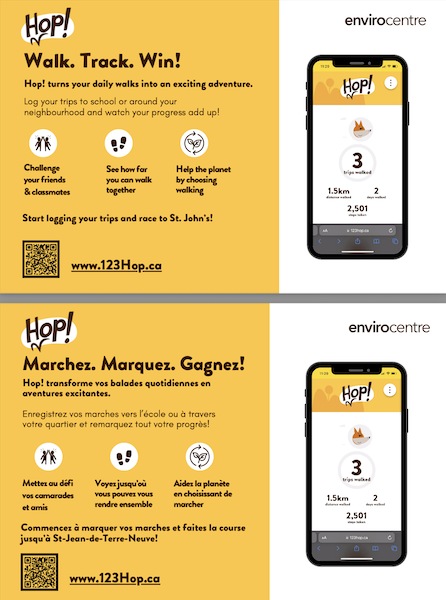Walking to school is both simple and impactful
School active transportation means getting to and from school (or part of the way) by walking or wheeling.

“Walking to school is a wonderful first step towards building long-term sustainable transportation habits in our city.”
Dzifa Binka, Project Lead, EnviroCentre
What are the benefits of school active transportation?

- Health: Walking and wheeling to school is a great way to promote physical activity. According to the 2024 ParticipACTION Report Card, only 39% of Canadian children (ages 5-17) are getting the recommended 60 minutes of moderate to vigorous physical activity per day.
- Safety: Active transportation reduces road congestion in the school zone, making it safer for everyone in the community.
- Community: Using active transportation helps people get to know their neighbourhood and builds a sense of community. As families walk to school or to the bus stop, they build relationships with each other and the neighbours that they see along the way.
- Air Quality: by not using a car to get to school, air pollution and greenhouse gas emissions in the school zone are reduced. This contributes to helping meet Ontario’s target of 30% reduction in GHG emissions by 2030.
- Lifelong habits: Studies show that children who walk, cycle, or ride a bus for transportation, at least some of the time, are likely to grow into young adults who walk, cycle, and use transit. By walking to school, children build positive attitudes toward active and sustainable transportation – benefiting themselves and the planet!
The School Active Transportation (SAT) program
As part of our commitment to advancing active and sustainable transportation options for Ottawa area residents, EnviroCentre is proud to deliver the School Active Transportation program on behalf of the City of Ottawa. The SAT program provides valuable support and resources to build active and sustainable transportation habits among Ottawa students, families, and school communities.
The Program uses a model developed by Green Communities Canada, called School Travel Planning, which is used across the country. It addresses the five E’s of transportation planning, which are guided by Equity and Engagement as overarching principles.
Education
Building skills with Bike Rodeos and pedestrian-safety workshops, sharing maps, tips, and resources with the entire school community to enhance active transportation.
Enforcement
Coordinating enforcement blitzes to encourage safe behavior in the school zone.
Encouragement
Holding Walk-to-School days, walking field trips, enhancing communications efforts, and friendly classroom competitions.
Engineering
Working with the City to identify infrastructure improvements, crossing guards, signage changes, and other measures to enhance walking and wheeling to school.
Evaluation
Conducting student and family surveys to track changes over time.

Increasing rates of active transportation
Approximately 26% of students in grades 6 to 10 in Canada typically use active modes of transportation to get to school. The goal of the SAT program is to increase these rates, and recent survey data shows that schools involved in the SAT program have higher rates of walking to school!
The 2022 OSTA Transportation Survey Report summarizes data about how families from the Ottawa Carleton District School Board and the Ottawa Catholic School Board travel to school. Survey results show that 32% of respondents from schools that have graduated from or are currently engaged in the SAT program walked all the way to school compared to 15% of respondents from schools that have never participated in the SAT program.
Hop!
A bilingual app that makes walking to school fun
Hop! is free and available for download by anyone. Schools are particularly encouraged to use it in their active transportation initiatives.

Hop! Resources
School Active Transportation Resources
English Resources
- Ottawa School Streets Feasibility Study
- Quick facts about school active transportation for school principals
- School active transportation overview
- School Safety Blitz Training Toolkit
- Tips for setting up school active transportation
- Tips for reporting traffic and safety concerns in school zones
- Tips for parents – Fitting active travel into your routine
- Walk-a-block maps:
- Walk to School Day – Event Planning Toolkit
French Resources
- Étude de faisabilité des rues scolaires à Ottawa
- Faits en bref pour les directions d’école sur le transport scolaire actif
- Survol sur le transport scolaire actif
- Conseils pour signaler les problèmes de circulation et de sécurité dans les zones scolaires
- Conseils aux parents – Marcher ou rouler pour se rendre à l’école
- Cartes « Faites le reste à pied » :
- Journée “Marchons vers l’école” – Trousse de planification d’événement
Multimedia Resources
Resources in other languages

The Top 5 Benefits of Active Transportation Infographic
This great new resource, highlighting the benefits of active transportation, is available in the ten most commonly spoken languages in Ottawa, including English, French, Arabic, Mandarin, Spanish, Cantonese, Farsi, Vietnamese, Somali, and Russian.
Download a copy (or copies) to share with your school community!
Find out how your school can participate
To find out how your school can participate in our SAT program, contact us or sign up for our quarterly newsletter.






